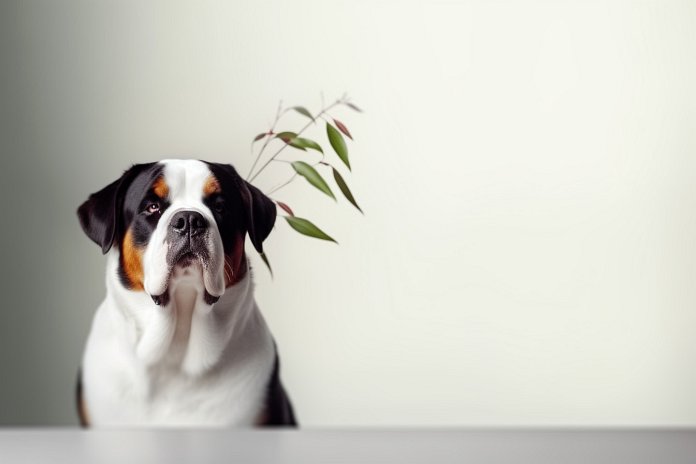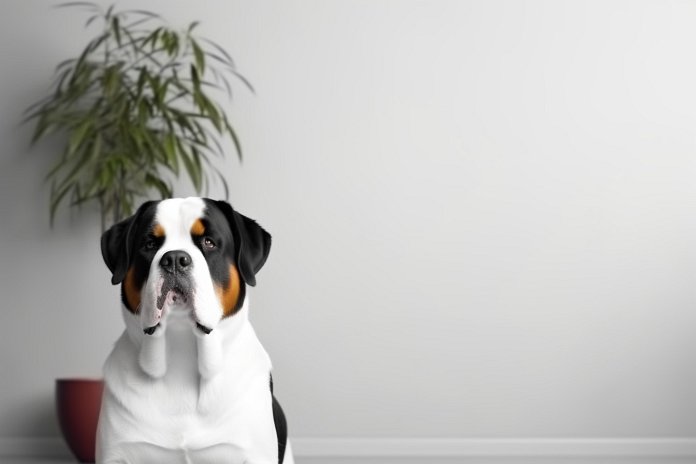
The Bull-Aussie is a unique mix of an Australian Shepherd and an English Bulldog. This designer breed is created from two purebred dogs and has a distinct set of characteristics. The Bull-Aussie is known for its powerful and large size. Its coat is typically short and thick, with minimal shedding. To keep this breed happy and healthy, it requires regular exercise such as daily walks and engaging activities.
In addition to its physical traits, the Bull-Aussie is highly intelligent, devoted, and loyal. It thrives in an energetic household where it can receive ample attention and opportunities to explore new things. This breed is best suited for owners who can provide the mental and physical stimulation it needs to lead a fulfilling life.
Below, we look at Bull-Aussie dog breed, its history, personality, pros and cons of owning an Bull-Aussie, characteristics, and must-see facts. We will also examine how to care for this breed and more. Prepare for a tail-wagging adventure into the world of Bull-Aussies!
| Dog Breed | Bull-Aussie |
| Size | Large |
| Weight | 50-70 lbs (average) |
| Height | 16-23″ (average) |
| Location | United States |
| Ancestry | English Bulldog, Australian Shepherd |
| Date of Origin | Unknown |
| Group | Companion |
| Life Expectancy | 11-15 years |
| Price | $600 – $800 |
| Family | Canidae |
| Scientific Name | Canis Lupus Familiaris |
📖 Breed History
The Bull-Aussie, a hybrid breed, has a relatively short history compared to its parent breeds. It is believed that this mix originated in the late 1990s in the United States. Unfortunately, there is limited recorded information about the Bull-Aussie. However, we can gain insight by looking into the backgrounds of its parental breeds.
One of the parent breeds, known as the Bulldog or British Bulldog, has a documented history dating back to the 1500s. Originally referred to as the Bolddogge and the Bondogge, this breed was initially used for bull-baiting and fighting. Over time, these cruel activities were banned, leading to changes in the breed’s physical attributes and temperament. Today, the Bulldog is a gentler and calmer breed, currently ranking as the 4th most popular breed in America according to the American Kennel Club.
The other parent breed, the Australian Shepherd, has its roots in the Basque region of the Pyrenees mountains. They acquired their name due to their association with Australian shepherds who migrated to the United States in the 1800s. These shepherds brought their herds of sheep and dogs, primarily settling in California. American breeders then began selectively breeding these dogs. In the 1950s and 60s, the Australian Shepherd gained popularity for their impressive tricks in rodeos. They continue to be utilized as herding dogs on ranches and serve as guide dogs for the blind, members of search and rescue teams, and even in drug detection. The breed was officially recognized by the American Kennel Club in 1991 and has found its way into the homes of celebrities such as James Brolin, Mel Gibson, Steven Spielberg, and Alyssa Milano.

🐕 Bull-Aussie Appearance
The Bull-Aussie will resemble both the Australian Shepherd and the English Bulldog. He’ll be a big dog with well-defined, muscular muscles. His legs will be taller than those of a normal Bulldog father. He might have a medium-sized snout and a wide skull. Typically, the Bull-Aussie has a short, thick coat that is simple to care for. He may have lengthy fur covering his chest and neck. Your hybrid will feature expressive, wide eyes that might be black or blue, as well as folded drop ears. The tail frequently bobs in a natural way. Typically, brindle, black, cream, and white are the colors of coats.
| 👀 Eye Color | Blue |
| 🐽 Nose Color | Black |
| 🐕 Coat Color | Brindle, Black, White, Cream |
⚡ Fun Fact: Bull-Aussie dogs are a social breed. They enjoy being around people or other animals. This breed doesn’t tolerate being left alone.
🐶 Traits & Temperament of Bull-Aussie
For the Bull-Aussie, early socialization and obedience training are advised. They are clever and rather easy to train, but they will perform at their best under the guidance of a strict handler who can display leadership and constancy. The Bull-Aussie will like meeting and mingling with other dogs if socialized early. High energy dogs like the Australian Shepherd need a “job” to do. When he has a goal, he is the happy. The English Bulldog is more laid back yet still likes activities. As a result, your Bull-Aussie may have a medium level of activity, a herding propensity, and make an effort to “herd” youngsters or smaller animals. The Bull-Aussie is a loving dog who appreciates spending time with a family that is active. They often get along well with kids. A little patience is required since he can develop more slowly due to his English Bulldog heritage.
🤝 Are Bull-Aussies Friendly or Aggressive?
Bull-Aussie dogs are known for their friendly nature towards other pets, making them a great choice for households with multiple animals. They are also very sociable with strangers and tend to get along well with people they don’t know. This breed is particularly kid-friendly and enjoys being in the company of children. Bull-Aussie dogs are also cat-friendly and can easily coexist with feline companions. Additionally, they are dog-friendly, making them a good fit for families who want to have multiple dogs or participate in dog meetups. Lastly, Bull-Aussies are highly recommended for elderly individuals, as they are considered one of the best breeds for seniors.
This breed is known for being:
- Active
- Loving
- Protective
- Courageous
- Intelligent
- Friendly
- Affectionate
- Social
- Sweet
- Aggressive
- Good-natured
🐩 Bull-Aussie Care & Maintenance
Once every week, the Bull-Aussie should be brushed. Regular brushing will keep his hair lustrous and assist to remove dead hair and promote shedding. It is advised to take a moderate wash bath once a month. It’s crucial to completely dry his fur and ears to prevent moisture buildup, which might result in an illness. If your Bull-Aussie develops skin folds, as is frequently the case with Bulldogs, you should check, clean, and dry them every day. Because the Bulldog is prone to skin irritation, maintaining good skincare is crucial. For the purpose of preventing periodontal disease, the teeth of the Bull-Aussie should be cleaned with canine tooth paste several times each week. Maintaining your hybrid’s nails is important. If you start your Bull-Aussie’s grooming routine when he is a puppy, he will grow to enjoy the care and connection.
Bull-Aussie dogs have a moderate shedding level, which is a normal part of their hair growth cycle. Regular brushing can help minimize the amount of hair they shed. The shedding amount can vary depending on their overall health and the specific breed they belong to. In terms of bathing, it is recommended to give Bull-Aussie dogs a bath every 6-8 weeks.
🍖 Food: We recommend 3 cups daily, costing you about $1.50 – $1.90 daily, or approximately $39.00 – $52.00 a month.
🐾 Exercise: Bull-Aussie dogs have an average exercise need. This breed is satisfied with short walks every weekday and a long ones on weekends.
This dog breed requires to be walked for roughly 9 miles per week, which equates to about 45 minutes of physical activity daily. This consistent moderate exercise regimen will help maintain their physical wellness and significantly contribute to their mental stimulation. Consciously setting aside this time for your furry friend can dramatically enhance their life quality, helping them stay energetic, healthy, and mentally alert.
Did you know: Bull-Aussie dogs have a higher energy level than other dog breeds. If you want a dog for snuggling on the couch, this breed isn’t the perfect choice for you.
❤️🩹 Bull-Aussie Health & Issues
Some of the major concerns for Bull-Aussie Dog Breed can be:
- Entropion
- Deafness
- Cherry Eye
- Hip Dysplasia
- Hypothyroidism
- Dry Eye
While minor concerns include:
- Cataracts
- Retinal Dysplasia
- Diabetes
- Heart Murmur
🤧 Important: Is Bull-Aussie hypoallergenic? No.
✨ Bonus: Check out cool, creative, and funny names for Bull-Aussie.
⚡ Bull-Aussie Dog Breed Facts
What makes the Bull-Aussie a great choice for families with young children?
The Bull-Aussie is a great choice for families with young children because they are known to be affectionate and good with children. They are usually patient and gentle, making them suitable companions for kids.
Is the Bull-Aussie breed considered a suitable breed for apartment living?
The Bull-Aussie may not be considered a suitable breed for apartment living due to their large size and moderate shedding. They require a decent amount of exercise and space to roam around.
How much exercise does a Bull-Aussie require compared to other breeds?
The Bull-Aussie requires a significant amount of exercise compared to some other breeds. They are high energy dogs and need daily walks, activities, and exercise to keep them mentally and physically stimulated.
Is the Bull-Aussie breed known for being good with other pets?
The Bull-Aussie breed is generally good with other pets if properly socialized. However, their herding instinct may cause them to attempt to “herd” smaller animals or children, so careful supervision is necessary.
What are other low-maintenance dog breeds similar to the Bull-Aussie?
Some low-maintenance dog breeds similar to the Bull-Aussie include the Boston Terrier, French Bulldog, and Cavalier King Charles Spaniel. These breeds have less exercise and grooming requirements.
What are the common health issues that Bull-Aussies are prone to?
Bull-Aussies are prone to some common health issues that can affect both English Bulldogs and Australian Shepherds. These include hip dysplasia, eye problems, and allergies. Regular vet check-ups are important to maintain their health.
Are Bull-Aussies known to be easy to train compared to other breeds?
Bull-Aussies are highly intelligent and relatively easy to train. However, they do best with a firm handler who can provide consistent leadership. Early socialization and obedience training are recommended to ensure they become well-behaved dogs.
Are Bull-Aussies more prone to separation anxiety compared to other breeds?
Bull-Aussies may be more prone to separation anxiety compared to some other breeds. Their loyalty and attachment to their family can make them anxious when left alone for extended periods. Proper training and gradually increasing their alone time can help alleviate this.
Are there any dog breeds similar to the Bull-Aussie that are suitable for people with allergies?
Some dog breeds similar to the Bull-Aussie that are suitable for people with allergies include the Poodle, Portuguese Water Dog, and Bichon Frise. These breeds have hypoallergenic coats that produce less dander.
What sizes of dogs similar to the Bull-Aussie are best for individuals or families with limited space?
Smaller-sized dogs similar to the Bull-Aussie, such as the Miniature Australian Shepherd or the English Bulldog, are better suited for individuals or families with limited space. These breeds can adapt well to smaller living environments.
Is the Bull-Aussie breed known to be good with children with special needs?
The Bull-Aussie breed can be good with children with special needs, but it is important to supervise interactions and provide proper training and socialization. Each individual dog’s temperament should be considered when determining their suitability for specific needs.
How does the grooming and shedding needs of the Bull-Aussie?
The grooming needs of the Bull-Aussie can vary depending on their coat type. While they have mostly short and dense coats, they do shed moderately. Regular brushing can help manage shedding. Compared to some other breeds, they may require slightly more grooming due to their herding dog heritage.
We use reliable and publicly available data and resources such as AKC and American Canine Registry to ensure that Bull-Aussie dog breed information is accurate and up to date. If you spot an error, please don’t hesitate to bring it to our attention.